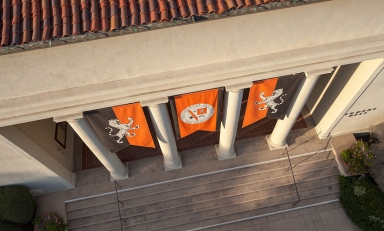The politics of HIV/AIDS, why people believe in ghosts, and the potential of what is known as Marangoni flow were among the student-faculty research projects showcased at Occidental College’s 13th annual Summer Research Conference July 30.
Rigorous undergraduate research – a signature program at the College – allows Occidental students an opportunity for intensive study that would otherwise have to wait for graduate school. Sponsored by the College’s Undergraduate Research Center (URC), the conference highlighted the collaboration of 81 students and 50 faculty members in a wide range of disciplines. Ten weeks of summer research culminated with students either presenting a poster or giving an oral presentation detailing their work.
"Summer research allows us to study what we want to study and learn how to research," said Amanda Armstrong ’09, a politics major who worked with professor Regina Freer (her academic advisor) on her project, Today’s Boundaries of Blackness: Is Secondary Marginalization Still Applicable to the HIV/AIDS Crisis in 2008? "It’s the only time of year when you can focus solely on your research project and not be distracted by other demands on your time."
Armstrong determined, through researching conventional media, that, although stories pertaining to the fastest-growing group affected by HIV/AIDS – poor, black women – do appear, they are often connected with major mainstream stories like Magic Johnson’s 1991 announcement that he contracted HIV. In general, stories about black women with HIV/AIDS are largely absent and, although HIV/AIDS philanthropies are now plentiful, there is not a single outreach organization in Los Angeles (the country’s second largest city) whose primary clientele are black women.
Barry Kang ’10, a biochemistry major, works with his mentor Professor Eileen Spain on Coating Glass with Ag Nanoparticles via Marangoni Flow. Their project involves combining tiny particles of silver with different solvents and recording the resulting behavior of the mixture within a glass vial. "We put the nanoparticles into a system similar to oil and water," notes Kang. "When mixed, an emulsion is created, but the oil and water want to separate. Ultimately, the nanoparticles caught in the emulsion are driven up the walls of the vial spontaneously to lower the overall energy of the system."
Wine lovers know Marangoni flow as the "tears of wine" phenomenon that creates "wine legs" – wine that spontaneously moves up the interior of the glass, and then dribbles back down as it is swirled before tasting. Understanding fluid flow like the "tears of wine" phenomenon on a smaller scale – within ultra tiny volumes containing minute amounts of solutions – may one day help personalize medical devices for at-home use, possibly decreasing the need for large samples for testing. During Kang’s first year at Occidental, a chemistry teaching assistant suggested he work on Marangoni flow research. "The more I learned about it, the more interested I got. I enjoy going into the lab and trying to solve problems."
Although she doesn’t believe in ghosts herself, Sarah Aronow-Werner ’09 focused on how others view the paranormal. A cognitive science major, she worked with psychology professor Andrew Shtulman on her project, Understanding Paranormal Beliefs: Individual Differences in Evaluation of Evidence Where Science and Spirituality Meet. "I'm interested in how people arrive at a specific set of beliefs. I chose to focus on paranormal entities because belief in them falls outside the strict domain of most scientific or religious institutions," she said. Of her sample of 46 college students, she found that 21 thought of ghosts as some kind of non-human spirit, 18 participants did not believe in ghosts and seven envision ghosts as dead humans, or anthropomorphized spirits. Aronow-Werner wants to expand her research to include older adults and, in graduate school, she hopes to study how people structure beliefs that guide their health practices.
The conference’s keynote address speaker was Lemeneh Tefera, M.D. ’95. Trained in emergency medicine, Dr. Tefera is on staff at New York City’s Beth Israel Medical Center. He is also a member of Doctors Without Borders and he founded the New York State chapter of the American Academy of Emergency Medicine.
Occidental routinely has the largest contingent of participants at the Southern California Conference on Undergraduate Research (SCCUR) of any participating school. Since 2005, a total of 89 Occidental students have been invited to the National Conference on Undergraduate Research (NCUR). This year’s group of 34 presenters included more students than Harvard, Caltech, Berkeley, UCLA and USC combined.
Director of the Undergraduate Research Center (URC), professor Chris Craney and URC administrator April Mazzeo organize the Summer Research Conference annually. Occidental College’s thriving undergraduate research program is made possible by generous funding from dozens of foundations, charitable trusts and individual donors.



